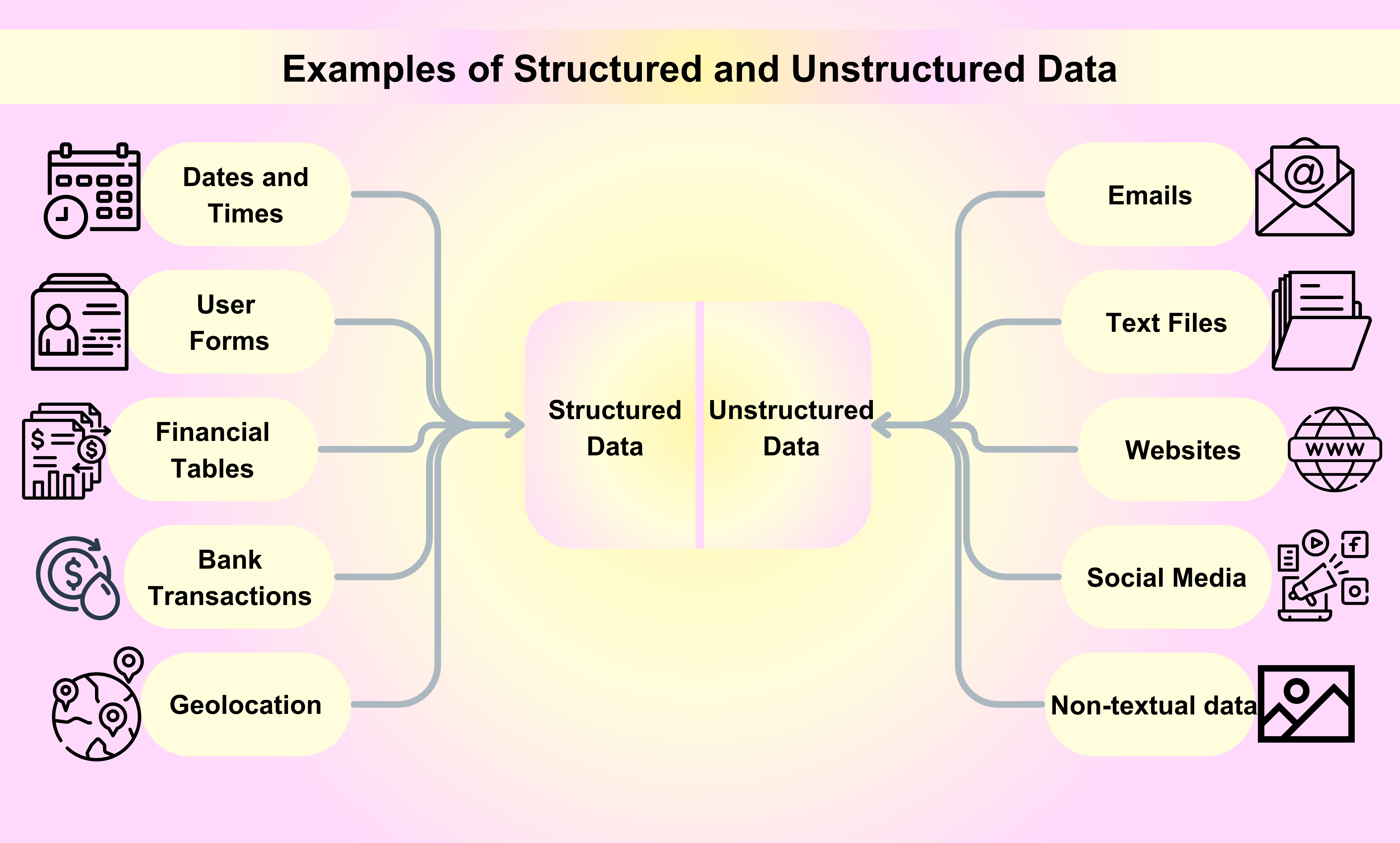What Is Structured Data and Unstructured Data
In the digital information era, data is generated at any time, and enterprises create value through the analysis and processing of data. Therefore, collecting and recording data and processing and analyzing data have become two important tasks in business operation. In the process of data collection, unstructured data are encountered more often, the source and form of these data are diverse, and it is difficult to be classified or searched simply. Effective data ingestion is essential for organizations to efficiently transform raw data into actionable insights. In the process of data processing, the more encountered is structured data, which has a clear structure, well-defined information, and can be easily organized, searched and analyzed. Therefore, transforming unstructured data into structured data is an important step for enterprises to utilize the value of data.
Structured Data
Structured data is data that fits into a predefined data model or schema. It is particularly useful for dealing with discrete, numeric data such as financial operations, sales and marketing figures, and scientific modeling.
Structured data is typically quantitative and organized in a way that makes it easily searchable. It includes common types like names, addresses, credit card numbers, telephone numbers, star ratings, bank information, and other data that can be easily queried using SQL in relational databases.
Examples of structured data in real-world applications include flight and reservation data when booking a flight, and customer behavior and preferences in CRM systems like Salesforce. It is best for associated collections of discrete, short, noncontinuous numerical and text values and is used for inventory control, CRM systems, and ERP systems.
Structured data is stored in relational databases, graph databases, spatial databases, OLAP cubes, and more. Its biggest benefit is that it is easier to organize, clean, search, and analyze, but the main challenge is that all data must fit into the prescribed data model.
Unstructured Data
Unstructured data is data without an underlying model to discern attributes. It is used when the data won't fit into a structured data format, such as video monitoring, company documents, and social media posts.
Examples of unstructured data includes a variety of formats such as emails, images, video files, audio files, social media posts, PDFs, and more. Approximately 80-90% of data is unstructured, which means it has huge potential for competitive advantage if companies can leverage it.
Examples of unstructured data in real-world applications include chatbots performing text analysis to answer customer questions and provide information, and data used to predict changes in the stock market for investment decisions. Unstructured data is best for associated collections of data, objects, or files where the attributes change or are unknown, and it is used with presentation or word processing software and tools for viewing or editing media. Unstructured supplementary service data, such as social media posts and customer feedback, can provide valuable insights when converted into structured formats.
It is typically stored in data lakes, NoSQL databases, data warehouses, and applications. The biggest benefit of unstructured data is its ability to analyze data that can't be easily shaped into structured data, but the main challenge is that it can be difficult to analyze. The main analysis technique for unstructured data varies depending on the context and the tools used.
Difference between structured and unstructured data
Advantages of Structured Data and Disadvantages of Unstructured Data
Structured data offers the advantage of being easily searchable and used for machine learning algorithms, making it accessible to businesses and organizations for interpreting data. There are also more tools available for analyzing structured data than unstructured data. On the other hand, unstructured data requires data scientists to have expertise in preparing and analyzing the data, which could restrict other employees in the organization from accessing it. Additionally, special tools are needed to deal with unstructured data, further contributing to its lack of accessibility.
Structured Data Analytics vs. Unstructured Data Analytics
Structured data analytics is typically more straightforward because the data is strictly formatted, allowing the use of programming logic to search for and locate specific data entries, as well as to create, delete, or edit entries. This makes automating data management and analysis of structured data more efficient. In contrast, unstructured data analytics does not have predefined attributes, making it more difficult to search and organize. Unstructured data analytics often requires complex algorithms to preprocess, manipulate, and analyze, posing a greater challenge in the analysis process. The analysis of unstructured supplementary service data often requires advanced parsing techniques to extract meaningful information.
Structured Data Management vs. Unstructured Data Management
The management of structured data is generally more efficient due to its organized and predictable nature. Computers, data structures, and programming languages can more easily understand structured data, leading to minimal challenges in its use. Conversely, unstructured data management presents two significant challenges: storage, as unstructured data management is typically facing larger processing than structured data management, and analysis, as unstructured data management is not as straightforward as analyzing of structured data managements. To understand and manage unstructured data, computer systems must first break it down into understandable components, which is a more complex process.
Summary of Difference between Structured and Unstructured Data
Structured data is defined and searchable, including data like dates, phone numbers, and product SKUs. This makes it easier to organize, clean, search, and analyze compared to unstructured data, which encompasses everything else that is more difficult to categorize or search, such as photos, videos, podcasts, social media posts, and emails. One sentence to explain the difference between structured and unstructured data: Most of the data in the world is unstructured, but structured data's ease of management and analysis gives it a significant edge in applications where data can be neatly organized and quickly accessed.
Examples of Structured and Unstructured Data

Structured Data Examples
-
Dates and Times: Dates and times follow a specific format, making it easy for machines to read and analyze them. For instance, a date can be structured as YYYY-MM-DD, while a time can be structured as HH:MM:SS.
-
Customer Names and Contact Information: When you sign up for a service or purchase a product online, your name, email address, phone number, and other contact information are collected and stored in a structured manner.
-
Financial Transactions: Financial transactions such as credit card transactions, bank deposits, and wire transfers are all examples of structured data. Each transaction comes with specific information in the form of a serial number, a transaction date, the amount, and the parties involved.
-
Stock Information: Stock information such as share prices, trading volumes, and market capitalization is another example of structured data. This information is systematically organized and updated in real-time.
-
Geolocation: Geolocation data, including GPS coordinates and IP addresses, is often used in various applications, from navigation systems to location-based marketing campaigns.
Unstructured Data Examples
-
Emails: Emails are among the most popular unstructured data examples we use every day for business or personal purposes.
-
Text Files: Examples of unstructured data are including Word processing files, spreadsheets, PDF files, reports, and presentations.
-
Websites: Content from websites like YouTube, Instagram, and Flickr is considered as example of unstructured data.
-
Social Media: Data generated from social media platforms such as Facebook, Twitter, and LinkedIn is example of unstructured data.
-
Media: Digital images, audio recordings, and videos represent a huge amount of non-textual data in an unstructured manner that can be regarded as unstructured data examples.
Techniques for Structured Data Analysis
-
SQL Queries: Structured data can be efficiently queried using SQL (Structured Query Language), which allows for quick retrieval and manipulation of data stored in relational databases.
-
Data Warehousing: Structured data can be stored in data warehouses, which integrate data from multiple sources and support complex queries and analysis.
-
Machine Learning Algorithms: Algorithms can easily process structured data to identify patterns and make predictions.
Structured data is easy to understand and manipulate, making it accessible to a wide range of users. Structured data allows for efficient storage, retrieval, and analysis, which speeds up decision-making processes. Structured data systems can scale to handle large volumes of data, ensuring that performance remains high as data grows.
Techniques for Unstructured Data Analysis
-
Natural Language Processing (NLP): NLP techniques are used to analyze text data, extracting meaningful information and insights from large volumes of unstructured text.
-
Machine Learning: Machine learning algorithms can be trained to recognize patterns in unstructured data, such as images or audio files.
-
Data Lakes: Unstructured data can be stored in data lakes, which allow for the storage of raw data in its native format until it is needed for analysis.
From the example of unstructured data analysis techniques, analyzing unstructured data is more complex and requires specialized tools and techniques. Processing unstructured data often requires significant computational resources and storage capacity. Unstructured data can contain inconsistencies, errors, or irrelevant information, making it challenging to ensure data quality. Streamlining data ingestion can significantly enhance an organization's ability to manage and analyze large volumes of data.
Examples of the Need to Convert Unstructured Data to Structured Data
-
Customer Feedback Analysis: Converting customer reviews and feedback from unstructured text into structured data allows businesses to perform sentiment analysis and identify trends in customer satisfaction.
-
Medical Records: Structuring unstructured medical records, such as doctor's notes and imaging reports, enables better integration with electronic health record (EHR) systems and improves patient care.
-
Compliance and Reporting: The process of data ingestion involves extracting, loading, and transforming data from various sources into a format suitable for analysis. Organizations may need to convert unstructured data into structured formats to comply with regulatory requirements and facilitate accurate reporting.
-
Market Research: Converting unstructured data from surveys and focus groups into structured data helps in analyzing market trends and consumer behavior.
How AnyParser Can Parse Unstructured Data to Structured Data
AnyParser, developed by CambioML, is a powerful document parsing tool designed to extract information from various unstructured data sources such as PDFs, images, and charts, and convert them into structured formats. It leverages advanced Vision Language Models (VLMs) to achieve high accuracy and efficiency in data extraction.
Key Features
-
Precision: Accurately extracts text, numbers, and symbols while maintaining the original layout and format.
-
Privacy: Processes data locally to ensure the protection of user privacy and sensitive information.
-
Configurability: Allows users to define custom extraction rules and output formats.
-
Multi-source Support: Supports extraction from various unstructured data sources, including PDFs, images, and charts.
-
Structured Output: Converts extracted information into structured formats such as Markdown, CSV, or JSON.
Steps to Parse Unstructured Data Using AnyParser
-
Upload Your Document: Begin by uploading your unstructured data file (e.g., PDF, image) to AnyParser's web interface. You can drag and drop your file or paste a screenshot for quick processing.
-
Select Extraction Options: Choose the type of data you want to extract. For example, if you need to extract tables from a PDF, select the 'Table Only' option.
-
Process the Document: AnyParser's API engine will process the document, accurately detecting and extracting the required information. The tool uses advanced VLM techniques to identify relevant data points and convert them into a structured format.
-
Preview and Verify: Review the extracted data using AnyParser's preview feature. Compare the initial extraction with the original document to ensure accuracy.
-
Download or Export: Once satisfied with the extraction, download the structured data file (e.g., CSV, Excel) or export it directly to platforms like Google Sheets for further analysis.
Benefits of Using AnyParser
-
Efficiency and Accuracy: Automates data extraction tasks, reducing manual effort and minimizing errors.
-
Data Security: Ensures sensitive information is processed locally, complying with data privacy standards.
-
Flexible Customization: Users can tailor extraction parameters and output formats to fit specific needs.
-
Enhanced Analytical Focus: Simplifies data extraction, allowing professionals to focus on higher-value analysis.
Applications
-
AI Engineers: Extract text and layout information from PDFs to develop and train AI models.
-
Financial Analysts: Extract numerical data from PDF tables for accurate financial analysis.
-
Data Scientists: Process large volumes of unstructured documents to uncover insights and trends.
-
Enterprises: Automate the processing and analysis of various documents, such as contracts and reports, to improve operational efficiency.
By leveraging AnyParser, users can transform complex unstructured data into structured, editable files, seamlessly integrating them into their workflows for enhanced data analysis and management.
Conclusion
In the digital age, converting unstructured data into structured formats using tools like AnyParser is crucial for businesses to unlock insights and gain a competitive edge. AnyParser can be utilized to parse unstructured supplementary service data, making it easier to integrate into business intelligence systems. By streamlining this process, organizations can efficiently harness the full potential of their data, driving better decision-making and strategic planning.




